After spending four months in the San Blas, doing short, 2-4 hour jumps at most, between anchorages, we now faced a thirty-some hour run to Cartagena, Colombia. We hadn’t planned to visit Colombia at all, but everyone we’ve met over the last 18 months who’s visited the city says not to miss Cartagena, so here we go . Like the forts we visited in Portobelo, Panama, the city’s historic walled area is also a World Heritage UNSECO site. We’ve been told that it has a very European feel, and are anxious to explore the area.
Whenever we settle in for an extended period, the thought of a long, overnight passage is unsettling. It’s always nerve wracking as we set out. Seas that were previously the norm for us, seem insanely huge until we get our passage “pants” back on.
Our trip got off to a more bumpy start than expected. As predicted, the winds and seas picked up overnight (not Scott or Howard’s favorite trip, so they weathered most of it out on the couch together). Thankfully, by the time we made the turn for our final leg, which was in a head sea, both wind and wave conditions had calmed wonderfully.
After 27 hours, we approached Cartagena Bay, noticing the increased presence of fast pleasure boats running in and out of Cartagena (yay….wakes!).

The Colombian National Navy has a base near Cartagena, and we saw several of their ships on our way into the harbor.

We passed the remains of several forts, their walls still mostly intact. At one time, all of Cartagena harbor’s natural entrances were protected by forts, and the huge Castillo San Felipe de Barajas that dominated the city to the east, from atop it’s rocky cliff.


Many of these forts are still standing in some form, and we passed several on our way into the bay.



After passing towns and villages, we eventually got our first glimpse at the modern skyline of Cartagena’s Boca Grande peninsula.


 To the west was Cartagena’s commercial port, reminding us of scenes from our home port of Baltimore, Maryland, and it’s busy commercial shoreline.
To the west was Cartagena’s commercial port, reminding us of scenes from our home port of Baltimore, Maryland, and it’s busy commercial shoreline.

As we came further into the harbor, the expanse of Boca Grande’s high rises came into clear view. The bright, white buildings with their blue and green glass windows gleamed among the palm trees and blue sky, very similar to the syline of Miami, Florida.

The Castillo Grande Lighthouse, and remains of Fort San Matias stand as a reminder of Cartagena’s history, among the modern skyline.
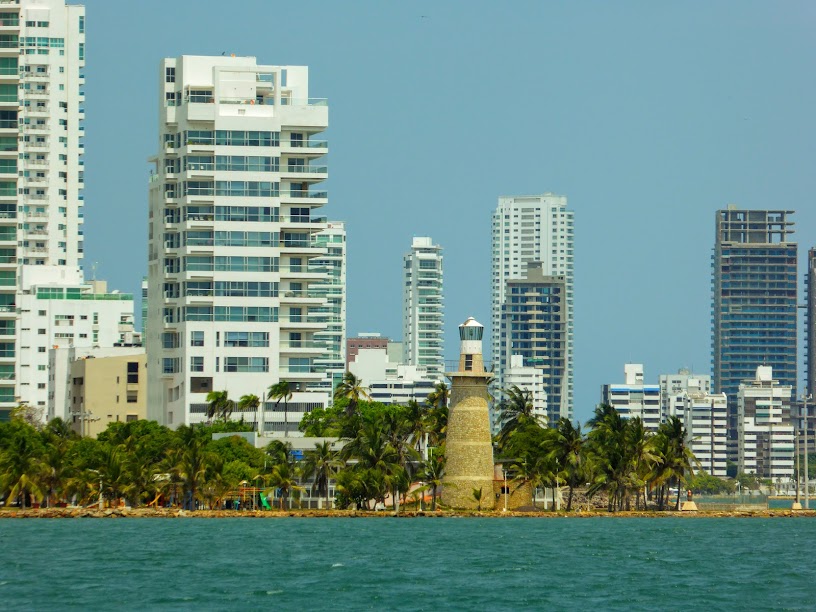

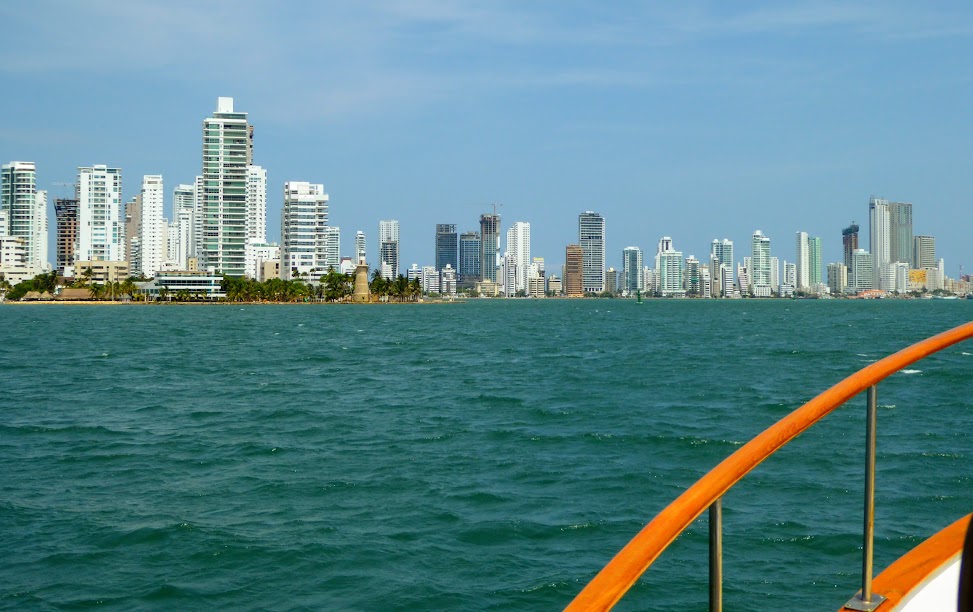
As we neared the harbor, the old, walled part of the city came into view, with it’s many church steeples rising into the midday sky.

We arrived at Club de Pesca, and headed for our slip. Docking was a bit challenging, as we only have one motor and don’t have the luxury of a bow thruster (they provide propulsion, making a boat more maneuverable). We usually rely on the outer poles of a slip, resting against one as we pivot into the place.
The slips at Club de Pesca didn’t have outer poles, and there were only finger piers on one side of our slip. That meant we had to come into the slip without making contact with the boat next to us, and without a pole to use for pivoting…making things extra challenging.
Luckily, our friends on s/v Sirena were docked right next to us, on the “open” side of the slip. They’d heard us hail the marina on vhf, and Shawna was out on the bow, in case she needed to fend us off. That left me free to keep watch on the very large boat on the other side of us, as he stuck pretty far out past the short finger pier. There’s always a flurry of activity, and calling back and forth as we back in, but everything went fine.
We were required to use an agent for clearing into Colombia, and Julio was waiting for us on the dock as we came around the corner to our slip. He collected our passports and other needed documents, and was off to begin our clear in process. We settled into our slip, with a great view Roman Bridge, and the edge of the walled city.


We could see over to the many church steeples in old town, and also had views of Castillo San Felipe; behind us, the skyline of Boca Grande.
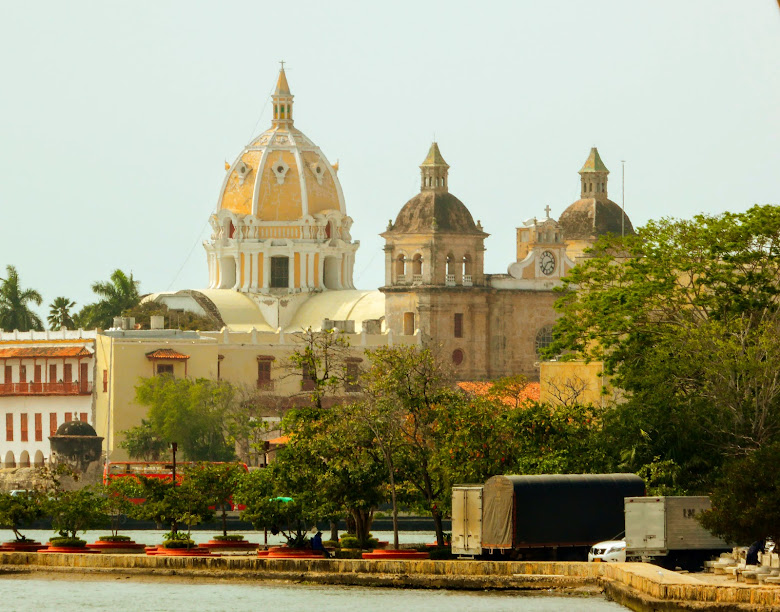
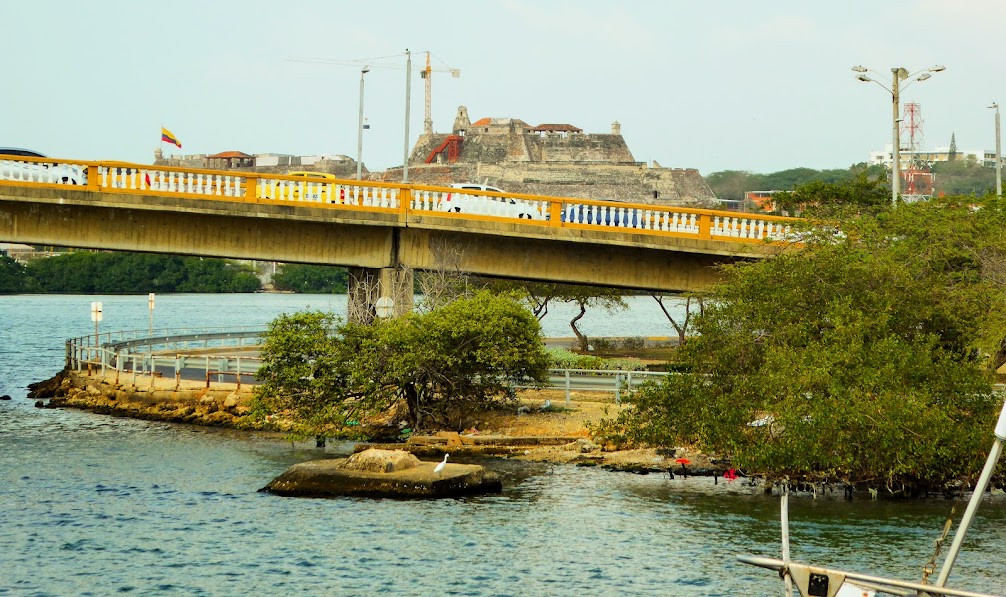

Howard took his usual post-passage, coma nap.
 Once rested it was “turtle” box time. He loves to get under this collapsed box and run around, wearing it like a shell. Throw in some string and a straw, and it’s pure bliss…cats are weird. After clearing in, it was time to again raise the Colombian courtesy flag, and Howard helped make sure we had the right one.
Once rested it was “turtle” box time. He loves to get under this collapsed box and run around, wearing it like a shell. Throw in some string and a straw, and it’s pure bliss…cats are weird. After clearing in, it was time to again raise the Colombian courtesy flag, and Howard helped make sure we had the right one.



Scott visited the atm to withdraw some cash. The exchange rate in Colombia (as we learned during our stays last year in Providencia and San Andres) is insane: 3,000 Colombian pesos to 1 US dollar; we’re millionaires here! Scott returned with a fist-full of bills…..20,000, 50,000, good grief!

We began to explore our surroundings. Shawna and Chris (s/v Sirena) filled us in on the need-to-knows: locations of grocery stores, restaurants, ice cream spots, etc., and we perused the marina grounds. It was a full house, with lots of daily activity, in the form of washing, waxing and detailing. I think most of the boats were cleaned more than they were used!

The fuel dock was a traffic jam every day, with boats of all sizes waiting in line to fill tanks and/or jugs. It was amusing for Scott to watch the organized chaos.


We stopped at one of the two restaurants on site for a happy hour cocktail, and were convinced that there was a meeting of the Colombian mafia at a nearby table. It was like a scene out of Scarface or Goodfellas. We remained quietly amused, not needing Colombian enemies.

Shawna had told me of the many kitties that call the marina grounds home. I bought some cheap cat food at the grocery store, and carried a bag with me whenever we came and went (Of course, I couldn’t get the bag out, without giving Howard some… I called it his McDonald’s treat). The cats came to know our step, and would pop out of their shelter spots, or run up to us for food.

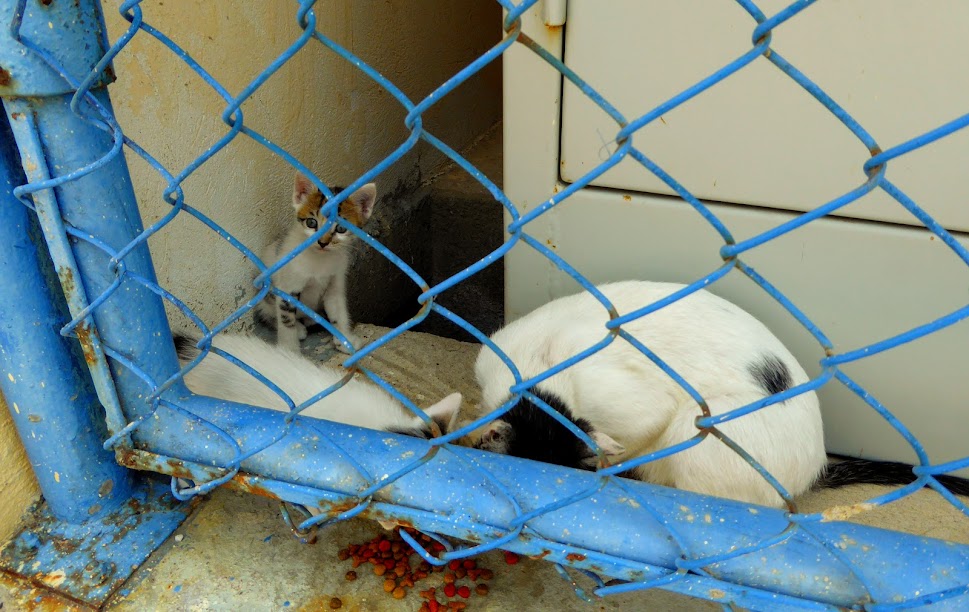
Groucho (aptly named by Shawna because of his black mustache) was one of my favorites. He was very vocal, always greeting us for food near the rear marina entrance. If I thought I could talk Scott into it, and if there was a chance that Howard would share his space….and food, we’d have a second cat.

Club de Pesca in located in the Manga neighborhood, just a short walk across the bridge from the walled city. It was a very safe area, and we enjoyed wandering the streets.

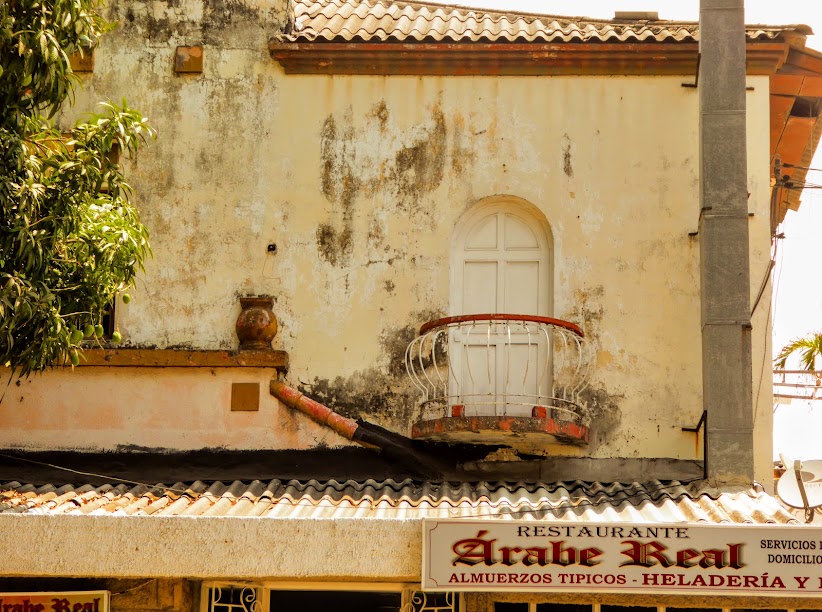
Of course….Scott can always sniff out a unique vehicle.

Shawna and Chris took us to their favorite local find, D’Res. It was just across the park outside the marina, and had terrific steaks at great prices! We returned several times, to get our red meat fix.

The streets of Cartagena are insanely clean, with crews sweeping them every morning. However, the condition of the sidewalks are treacherous. If you’re not frequently looking down as you walk, it’s easy to twist and ankle on the horribly uneven surfaces, or in the patches of rubble “repairs.”


In other places, exposed rebar and open holes wait to cause you harm, making it challenging to try and find your way along streets and across intersections, while looking down for these sidewalk traps.


In the late afternoon, when the marina office is closed, we enter through the old walls of Fort Manga, a daily reminder of the history surrounding us.


We ventured out to the nearby mall, in search of a sim card for our phone and of course, a McDonald’s fix for Scott. They made the food to order; still quick, but deliciously hot and yummy….. the best McDonald’s ever!!!
You couldn’t spit without hitting an ice cream place in the mall (or in all of Cartagena for that matter). I counted four, just in the food court area, including a McDonald’s stand-alone kiosk. At most locations, there is a separate ice cream counter, next to where you order burgers and fries. They’re serious about ice cream here.




Scott sought out a dermatologist in Boca Grande, and made an appointment for some routine scans. He walked there and back, past the high-rises and beaches. As a reward, he visited Burger King after the appointment, for another fast food fix. Much to his disappointment, it was not nearly as yummy as the McDonald’s food we’d enjoyed at the mall, much to his disappointment.



We were spending a month in Cartagena, so Scott took time for some boat projects. He replaced the raw water impeller, during routine maintenance of the pump. He finds it more thorough to just take the pump apart, so he can inspect all of it’s workings.

An oil change for the motor was also in order. During the process, he used a jiggle siphon to transfer oil from a five gallon bucket that he’d purchased in Bocas del Toro, to smaller containers for easier storage.

And, our poor, dirty cockpit got a fresh coat of paint…hurray!

As usual, we’re one of the smallest, oldest boats in the marina…but we’re ok with that. We’re enjoying our Cartagena home, and look forward to exploring the walled city!
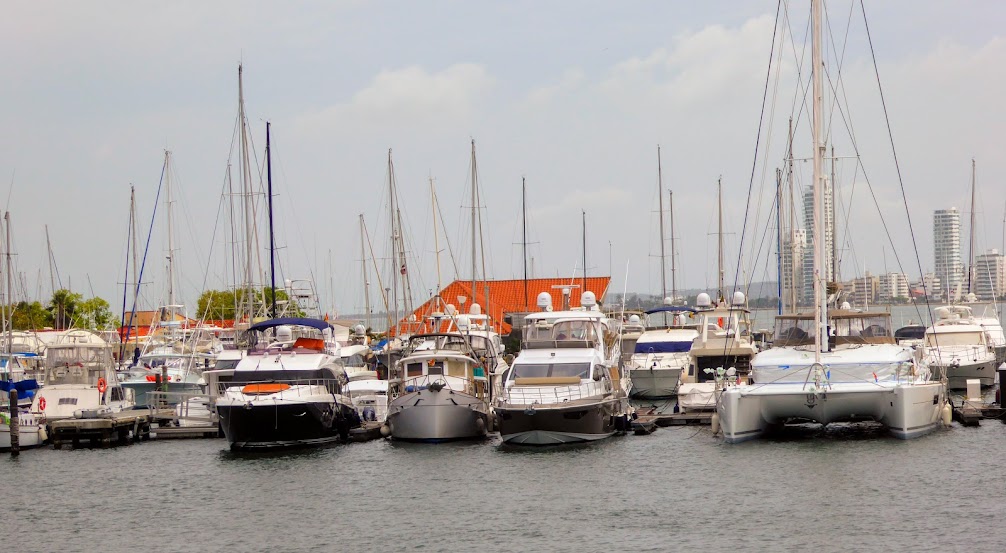

Here are more photos.
“Shells Sink, Dreams Float. Life’s Good On Our Boat!”

